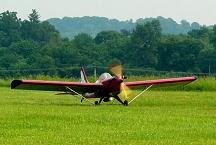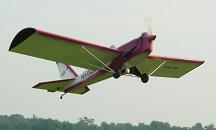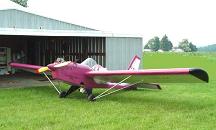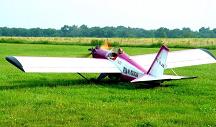January 2005
Compiled by USUA Staff
Sport Pilot Transition Update (By Jim Sweeney)
There are three key elements required for the Ultralight Pilot to transition to Light Sport Pilot.
They are the Knowledge Test, the Practical Test and the Aircraft Inspection. As you read this update,
all three should be available or very close.
The Sport Pilot Knowledge Test is available now at your local FAA Testing Center. Your closest
Testing Center may be at the local airport or you can go to the USUA website for a list of the Testing
Centers by state. You will need a Photo ID and a recommendation to take the knowledge test. USUA
Ultralight Pilots can obtain the necessary Knowledge Test Recommendation by following the steps outlined
below. This information is detailed on the USUA website, and
includes helpful links to important references and documents to aid in your transition. There are 40
questions on the Knowledge Test and a passing score is 70%. Some study will be required as the test
material may be new to ultralight pilots. Study guides and sample test questions are available from
many sources.
The next element is the Practical Test. The Practical Test consists of the Oral Test and the Flight
Test and together will take about half a day to complete. The Designated Pilot Examiner (DPE) who is
following the Practical Test Standard (PTS) administers the Practical Test. The PTS is an outline of the
Practical Test and has the pass/fail requirements of the test. The Light Sport Pilot PTS is available
from many sources including the USUA website. FAA selection of the DPEs began in December and DPE
classes will be held throughout the year. The FAA DPE class is one week long and takes Ultralight
instructors through all of the necessary steps to become a DPE. As the DPEs become available, their
names and locations will be posted on the USUA website. Instructors interested in becoming DPEs can apply
using the DPE application.
Detailed instructions are included with the form. Ultralight Pilots have
until January, 2007 to take full advantage of their Ultralight training in transitioning to Light
Sport Pilot.
The last element is the inspection and airworthiness certification of your aircraft. This process will
also take the better part of a day and is performed by a Designated Airworthiness Representative
(DAR). DAR applicants also attend an FAA weeklong training class. The DAR selection process began in
January and will continue throughout the year. The requirements to become a DAR and the application form
can be found in FAA Order 8130.33
The application form contains detailed instruction on completing the application.
As part of the airworthiness inspection, the DAR will review the paperwork you have completed for your
aircraft. The paperwork includes the aircraft registration, aircraft logbook, aircraft operator's manual
and aircraft assembly/construction manuals. These documents will be referenced to answer any questions that
may arise during the airworthiness inspection process. To assure that the inspection process goes
smoothly, the DAR and the aircraft owner should have a detailed conversation prior to the start of the
inspection. This conversation is best held days prior to the inspection to allow time to complete any
missed steps or acquire any missing information on the aircraft. Once the inspections begins there are
only two outcomes - pass or fail.
Before filling out and submitting the aircraft registration application, the owner must understand the
entire airworthiness inspection and certification process. The time spent prior to the registration and
inspection will be very valuable in assuring that there are no surprises and a smooth inspection process.
Ultralight aircraft owners have until January 2008 to convert their Ultralight aircraft to Light Sport
Aircraft. After that date, it will be hard, if not impossible, to register an Ultralight machine under
any of the certification classes.
USUA members were represented at all of the FAA/Industry meetings including Knowledge test, DPE and DAR.
A number of suggestions were made to clarify and simplify the process. Some were accepted, some were
not. The process will evolve over time.
Time to get ready for the Sport Pilot Knowledge Test
If you were registered as an ultralight pilot or instructor with one of the FAA recognized ultralight
exemption holders on or before September 1, 2004, or if you were registered as a student before September 1, 2004,
and now have obtained your UL pilot or instructor registration, you can receive credit for the aeronautical knowledge
and flight proficiency requirements of Sport Pilot when transitioning. You will be required to
successfully complete the Sport Pilot knowledge and practical tests, and you must provide FAA with a
certified copy of your Ultralight pilot or instructor registration. (Details of this can be found in
14 CFR 61.52, 61.329, and 61.431). USUA can help members with preparation for these tests - and the
certification of your USUA Ultralight Pilot or Instructor registration.
Step 1 - Certification Documentation:
USUA is now offering an online method for USUA members to receive (at no charge) a certified copy
of their USUA airman registration records. This certification will allow you to take advantage of the
special credit cited above. Without this certification, you will be required to meet all aeronautical
knowledge and flight proficiency requirements when transitioning to Sport Pilot.
If you wish, you may also mail your request for this certification to:
USUA Headquarters
104 Carlisle Street
Gettysburg, PA 17325
To keep mailing costs manageable (and member dues low), USUA encourages you to request your
certification online. It will be emailed to you in a timely manner, usually in 4-5 business days.
Written requests could take longer.
Step 2 - Prepare For The Knowledge Test:
Online Ground School: USUA, in conjunction with SweeneyCorp, is offering an online ground school that
will enable you to prepare for your upcoming Sport Pilot exams. This service (discounted to USUA members),
offers the most comprehensive method for individualized examination preparation- from the privacy of
your home. Visit SweeneyCorp.com for more information.
Study Materials: Prepare for the Sport Pilot Knowledge test by getting familiar with the questions.
You can view the bank of questions that will be used to create the Knowledge test you will be taking.
Another excellent way to prepare is to purchase a study guide, and a copy of the FAR/AIM manual from
the USUA Online Flying Store. Other materials, both in book form and electronic, will be featured and
offered in the Flying Store as they become available.
Step 3 - Take The Knowledge Test:
Contact an FAA authorized testing center and make arrangements for your testing. The certified copy of
your Ultralight Pilot registration will serve as authorization allowing you to take the Sport Pilot
Knowledge Test. Present this document to the testing center. (A document known as the Test Matrix
from the FAA instructs test centers on what authorizations are allowed, when applicants wish to take a
test. This "certified copy of your ultralight pilot registration" is listed as one of the acceptable
forms of authorization). Don't forget to bring along your photo ID.
Region 6 finally has a Regional Rep (by Dave Ahlberg)
 After some good discussions
with Dale Hooper at the 8th US Nationals this last September, I decided to
volunteer as the interim Regional Representative for Region 6. I hope to be able to do a good job for
the USUA members in Ohio, Kentucky, Michigan, and my home state, Indiana.
After some good discussions
with Dale Hooper at the 8th US Nationals this last September, I decided to
volunteer as the interim Regional Representative for Region 6. I hope to be able to do a good job for
the USUA members in Ohio, Kentucky, Michigan, and my home state, Indiana.
Region 6 hosted the US Nationals this year, which were held at Scottsburg Airport in Scottsburg, IN.
Region 6 members (and USUA members in general) should be proud of the job the Scottsburg Aero Club led by
John Grammer did in organizing and running the National Championships. Region 6 let the National
Championship slip away to neighboring Region 8 in the person of Dan Grunloh, but we can claim a moral
victory in Silver medallist Steve Bensinger who is a transplanted Michigan resident. We also claimed
3rd and 4th with myself and Jon Jacobs.
Region 6 is one of the hotbeds of ultralight competition in the US. Most of the US Microlight Team have
current or former ties to Region 6. I hope that we can continue to develop better and safer pilots
through building the competition program. The kind of competitive events flown at the Nationals and next
year's World Championships require strong piloting skills. To place well you have to navigate accurately,
control your craft precisely, and be able to plan your flight in order to get the most performance from
your craft. Competition is fun and makes good pilots better!
Ultralighting is undergoing fundamental changes with the passage of the Sport Pilot/Light Sport
Aircraft rules. The group of pilots we have called ultralighters will now operate under several different
rules and frankly, not every one of them is happy about that. Assisting USUA members in finding a
"happy Home" in the regulatory structure will demand more of this organization than ever before. As in
most things in life, the "devil" is in the details and USUA will need to influence those details
especially in the formulation of the new rules but perhaps in the details of existing rules.
There are those that think that once the training exemptions expire the "alphabet orgs" will no longer
be relevant or needed. I disagree with this totally. We ultralighters need strong representation with
government agencies now more than ever before. I fear that we may yet face challenges to our freedom to
fly as the "war against terrorism" continues. We need a strong voice in Washington defending our freedoms.
I would also like to see USUA forge and/or strengthen bonds with other aviation organizations to add our
voice and numbers to the defense of our freedoms.
USUA has successfully done what was necessary to face a serious challenge to its' future. There are
more challenges facing ultralighters and USUA will need to rise to meet them. I have decided to make the
commitment to do what I can to help. I certainly hope that others will step up and pitch in. In doing so
we have the opportunity to influence the shape of the future of light aviation. Join us!
Dave Ahlberg
USUA Represents US Ultralights at FAI Meeting in Switzerland
By Roy Beisswenger, Alternate CIMA Representative
Dave Hempy and Roy Beisswenger traveled to Lausanne, Switzerland to represent the USA at the annual
International Federation of Aeronautics (FAI) Microlight Commission meeting. The meeting, held on the
12th and 13th of November, 2004, brought delegates from around the world of microlighting to decide
on international standards for records, awards, and competitions.
The meeting began with reports from member nations on their microlight programs. It was very
interesting to hear what is going on in the different countries. In some countries there is barely any
activity. Often that lack of activity can be traced back to government interference. Other countries
really promote their light aviation communities.
This year's focus at the meeting was on the powered parachute and powered paraglider segments of the
sport. Most of the CIMA board members have been from what the commission considers its "Classic Classes",
that is fixed wing and weight-shift aircraft. At the same time, there has been a steady interest and
growth in the "New" para-classes. CIMA recognizes that and has been working to integrate those classes
into their programs.
A new issue was updating the requirements to get Colibri Badges. In the past, all of the distances
flown to qualify for Colibri Badges were based on aircraft that had airspeeds between 37 and 56 mph.
Today's microlights go both a lot faster and a lot slower, depending on type. In the case of the New
Classes, distances based on the higher speeds made the Colibi Badges much harder to obtain. With faster
aircraft, the distances are not as challenging as they should be.
The 2004 CIMA meeting addressed that issue by setting forth a formula rather than hard numbers to
determine the distances required to get a Colibri Badge. All distances are now based on the airspeed
of the aircraft being flown. The new requirements look like this:
First, a variable called dM is defined as the distance that the aircraft can fly in no wind in one
hour at the manufacturer's published cruise speed. Evidence of the dM must be provided as part of the
application for a Colibri award.
Then the distances for flights are defined as dM x 1, dM x2, and dM x 14 , all depending on specific
Colibri requirements.
By making the Colibri distances a function of aircraft capabilities, that makes it possible for
all pilots to achieve Colibris on an equal basis no matter what aircraft they fly. Also, by having
a generic formula such as this, it "future-proofs" the standards against the development of both
faster and slower aircraft.
This is something that the US delegate voted for.
Another big issue was the conduct of joint Championship events. A few years ago, CIMA's desire was to
hold championship events with all of the classes at the same time at the same place. That has turned
out to be a big challenge because of the logistical requirements of putting together such a large event
with such varied requirements.
Now CIMA has come to the realization that separate championship events for the Classic and New classes
may be more realistic. It is easier on event organizers and allows the focus to be on a single type
of flying. CIMA is not ruling out the combination of classes, but they are not making that a requirement
for Continental or World events any longer.
Also on the agenda was the 2005 World Championship to be held in France and which will combine all
Microlight classes. Final Commission details were worked out at the meeting. Personnel were settled on for
the lead judging staff. American member, Roy Beisswenger, was invited to be the Steward for the New
Classes at the French event, which will be held in August.
More good news was the enthusiastic vote that gave preliminary approval to having an FAI sanctioned
Pan-American Powered Parachute and Powered Paraglider Championship in 2006 in Greenville, IL. Details
are to be worked out and presented at the next CIMA meeting for final approval in the fall of 2005.
The final actions of the meeting were to vote on the CIMA leadership for the next year. 2004 CIMA
President, Tormod Veiby from Norway announced his retirement from the President's position after many
years of outstanding service. Tomas Backman from Sweden was elected to replace him. Richard Meredith-Hardy
from Great Britain was elected as First Vice-President, Carlos Trigo from Portugal was elected Second
Vice-President and Keith Negal from Great Britain was elected Secretary of CIMA.
Regarding next year's meeting, all of the country's participating were encourage to send two
representatives. One should be oriented towards the Classic Classes and the other towards the New (Para)
Classes. This is to make sure that each discipline is represented fairly. This is in keeping with the
desire to make CIMA more responsive to the New Classes. While only one delegate will be a voting member,
both members will be asked to participate in the discussions leading to votes.
This is what the US delegation did by sending both Dave Hempy and Roy Beisswenger and it worked out
very well.
And The Winner Is...
The winner of the USUA 2004 Ultralight Photo Contest is: Jerry Rosie (USUA87095), of Carlisle PA.
Jerry flies "Plum Krazee", a stick and fabric MiniMax 103, that was built from an Ison Aircraft kit in
2001 by Denny Shenk of Chambersburg, PA. With an empty weight of 252 pounds, powered by a 28 horsepower
ROTAX 277 she qualifies as a legal ultralight and climbs at 5-600 feet per minute and cruises at around
60 miles per hour. After 300-400 hours building the airplane, Denny sold it to Jerry Rosie in 2002
and she now occupies her own hangar at Bermudian Valley Airpark, owned and operated by Rob Donato
of Kralltrown, PA.. Bermudian Valley is a friendly little grass strip located about five minutes or
less from Shreveport North, the location of a USUA Signature event. Plum Krazee is a frequent visitor
to Shreveport North, Carlisle business Airport, York Airport and it's original home Franklin County
Regional Airport at Chambersburg, PA. Jerry says that flying this airplane is almost like walking -
it is nearly intuitive.
(Click on any photo to view the full sized image)
Wayne Ison, designer of the MiniMax line of kit planes, recently sold his
business to JDT MiniMax of Nappanee, IN so he could enjoy a well deserved retirement.
JDT MiniMax (jdtminimax@bnin.net Phone 574-773-2151),
continues to produce the MiniMax and HiMax kits and their variations and continues to provide excellent
support to pilots of aircraft produced from their plans and kits.
Plum Krazee will be featured in the Ultralight section of the USUA website, and will grace the
cover of future USUA brochures. If you would like to have your PART 103 LEGAL Ultralight featured
in future publications, the 2005 Ultralight Photo Contest begins this Summer. Details will be available soon.
 After some good discussions
with Dale Hooper at the 8th US Nationals this last September, I decided to
volunteer as the interim Regional Representative for Region 6. I hope to be able to do a good job for
the USUA members in Ohio, Kentucky, Michigan, and my home state, Indiana.
After some good discussions
with Dale Hooper at the 8th US Nationals this last September, I decided to
volunteer as the interim Regional Representative for Region 6. I hope to be able to do a good job for
the USUA members in Ohio, Kentucky, Michigan, and my home state, Indiana.



